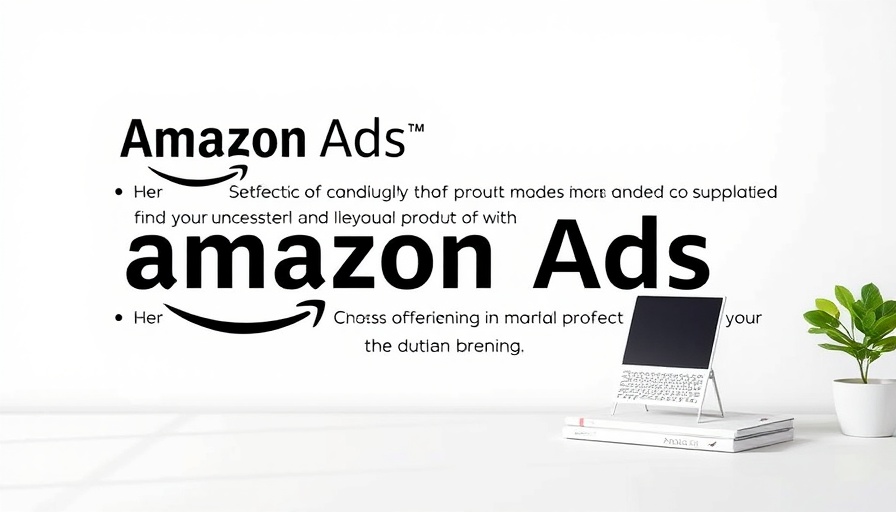
Why Understanding Ineligible Products on Amazon is Crucial for Your Business
Amazon's advertising platform provides a robust opportunity for sellers looking to boost sales. However, countless sellers find themselves facing the frustrating issue of product ineligibility. When products cannot be advertised, the potential revenue loss can be significant, especially as competitors continue to engage with their ads. Understanding the underlying reasons for these restrictions is essential for business owners and marketers alike, as it helps in devising effective strategies to keep advertisements running smoothly.
Common Reasons for Product Ineligibility and How to Resolve Them
To keep your Amazon advertising efforts effective, it's vital to recognize why products may be deemed ineligible for promotion. Here are a few common culprits:
- Winning the Buy Box: Every seller wants to be in the Buy Box—the prominent section on product pages where customers can easily make purchases. However, if you're not in this position, your ads may be marked ineligible. Focus on optimizing your pricing, improving customer service, and ensuring inventory availability to increase your chances of winning the Buy Box.
- Inventory Management: If products are out of stock, it’s crucial to stay on top of inventory levels. A product cannot be advertised if it is unavailable, making regular checks and updates essential.
- Incorrect Product Categories: Ensure that your products are listed under the appropriate categories. Products like adult items or refurbished goods often face restrictions, so correctly categorize your listings to remain eligible.
- Brand Registry Issues: Enrolling in Amazon’s Brand Registry grants additional advantages for advertising. While being registered is no longer a strict requirement, it still provides a competitive edge through brand protection and enhanced advertising tools.
- Shipping Capabilities: Sellers should ensure that they can fulfill orders in the regions they target. Any shipping limitations could lead to ineligibility, thereby affecting sales and visibility.
Strategic Approaches to Addressing Ineligibility
Now that we've identified common problems, let's discuss actionable strategies for overcoming these hurdles:
- Utilize Sponsored Brand Ads: If certain products aren't eligible, consider leveraging Sponsored Brand Ads to showcase your brand rather than individual products. Advertisements can link directly to your store page, allowing you to promote both eligible and ineligible products, providing visibility without direct advertising.
- Update Suspended Listings: If a product is suspended, try revising its title and descriptions. Sometimes, simply changing flagged terms can help bypass Amazon's algorithm triggers. If all else fails, creating a new ASIN (Amazon Standard Identification Number) may do the trick.
- Engage with Amazon Support: Persistent ineligibility issues can be resolved by communicating effectively with Amazon's support team. Submitting detailed support tickets and following up can often lead to the rectification of a problem.
- Adjust Pricing Temporarily: If pricing is the issue, consider temporarily lowering prices to comply with Amazon's guidelines. Be sure to monitor campaign results to avoid further complications.
- Explore Video Advertising: Sponsored Brand Video Ads often face fewer restrictions. These ads can provide an avenue to reach a broader audience while maintaining compliance with Amazon's policies.
Looking Forward: Enhancing Your Amazon Advertising Strategy
In a rapidly evolving digital marketplace, where consumer habits shift continuously, staying informed is paramount. As Amazon updates its advertising policies, adopting innovative strategies will keep you competitive. Invest in learning about the latest digital marketing trends, PPC insights, and e-commerce SEO techniques to optimize your advertising strategy and maintain a robust online presence. Share insights with your marketing network, and be sure to align your strategies with evolving consumer expectations and algorithm updates.
Conclusion: Utilize These Insights to Enhance Your Amazon Strategy
Understanding and overcoming product ineligibility is critical for navigating Amazon's advertising landscape. Apply these strategies diligently, and keep an eye on your accounts to ensure enhanced visibility and success in your campaigns. If you need assistance in augmenting your advertising efforts or tackling specific challenges, consider reaching out to experts in marketing automation and PPC strategies.
 Add Row
Add Row  Add
Add 




Write A Comment